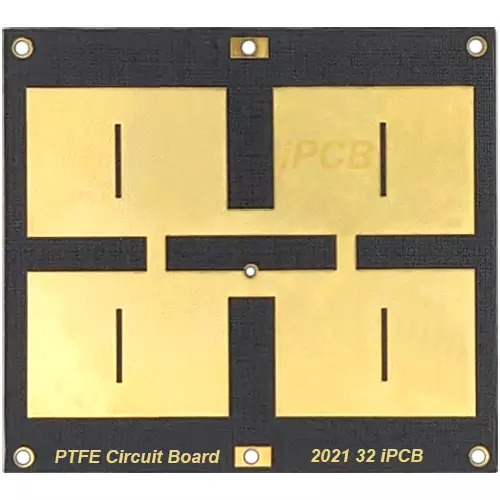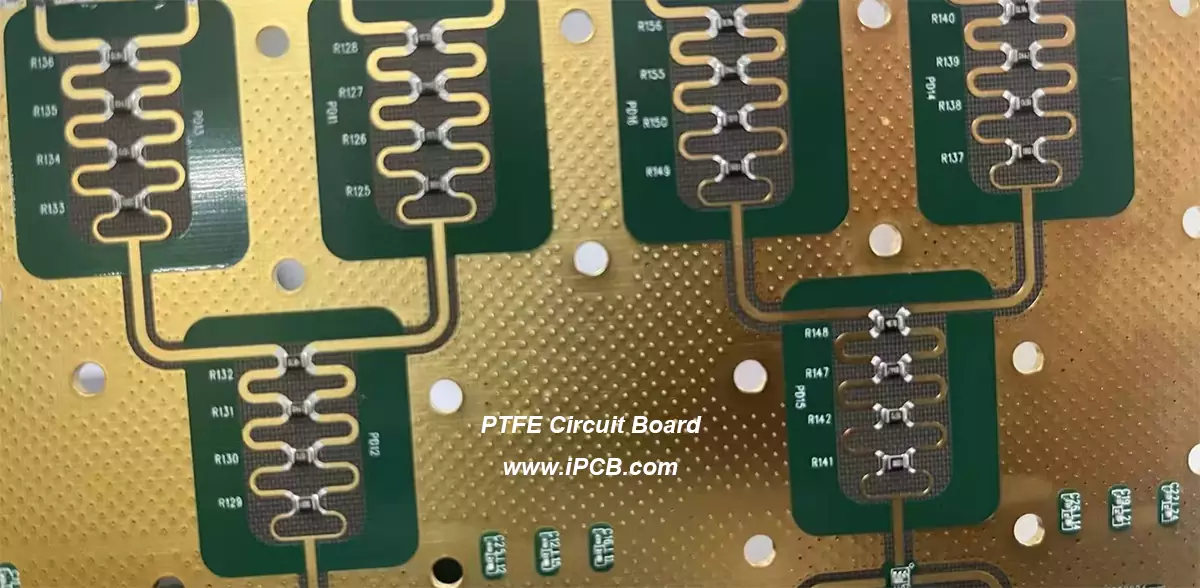
Product Name: PTFE PCB
Dielectric constant (DK): 2.2, 2.55, 2.65, 2.75, 2.85, 2.95, 3.0, 3.3, 3.5
Tangent loss (DF): 0.0030
Copper adhesion: 12ibs/inch
Water absorption: ≤ 0.02%
Surface resistance: 1X1016 ohm
Body resistance: 1X1012 ohm
Working temperature: -100 to+150 ℃
Teflon PCB features: low loss, low cost, strong copper foil adhesion
Applications: power amplifier, low-noise amplifier, antenna
What is PTFE PCB circuit board?
PTFE PCB is a widely used high-performance high-frequency circuit board in many electronic devices, characterized by high temperature resistance, chemical stability, electrical insulation, and moisture resistance.
Polytetrafluoroethylene circuit board is also PTFE PCB or Teflon PCB. PTFE is an artificially synthesized polymer material that uses fluorine to replace all hydrogen atoms in polyethylene. This material has the characteristics of acid and alkali resistance, resistance to various organic solvents, and is almost insoluble in all solvents. At the same time, polytetrafluoroethylene (PTFE) has the characteristic of high temperature resistance, and its friction coefficient is extremely low, so it can be used for lubrication and also for coatings.
PTFE PCB board has excellent characteristics and is widely used in microwave circuits, radar systems, satellite communication equipment, wireless communication, RF amplifiers, aerospace fields, and high-temperature industrial equipment.
Characteristics of PTFE circuit board
PTFE PCB can operate for a long time at temperatures up to 280 ℃ without melting, deforming, or degrading due to high temperatures.
PTFE PCB itself is an inert substance, and the reinforcing agents and fillers added to PCB materials are also chemically stable materials. They can withstand the corrosion of most chemical substances such as acids, alkalis, oxidants, and reducing agents, and will not be corroded by them. They can operate stably for a long time.
PTFE PCB has high insulation strength, low dielectric constant, and low dielectric loss, which can effectively prevent electrical breakdown, ensure clear and stable signals, and improve circuit reliability.
PTFE circuit board is a non absorbent material that can effectively prevent the infiltration of moisture and water, protect the components and circuits in the circuit board from being corroded by humid environments, and thus extend the service life of the circuit board.
Disadvantages of PTFE PCB circuit board
1. Cold flowability: PTFE PCB material has a certain degree of cold flowability, which may cause slight changes in the shape and size of the material in certain applications.
2. Processing difficulty: Due to the special properties of PTFE PCB, such as high lubricity and non adhesiveness, its processing difficulty is relatively high. During the PCB wiring and drilling process, issues such as air gouging or tearing are prone to occur.
3. High cost: Compared to traditional FR-4 materials, the cost of PTFE PCB is significantly higher. This is mainly due to its special production process and material costs.

PTFE circuit board
FAQ for PTFE PCB
How high temperature can PTFE PCB withstand?
PTFE PCB can typically withstand temperatures up to 260 ° C and have excellent high-temperature stability.
What specific fields are PTFE PCB suitable for?
PTFE PCB board perform well in fields such as communication equipment, RF applications, and high-temperature environments.
Is the manufacturing process of PTFE circuit board complicated?
Yes, the manufacturing process of PTFE PCB is relatively complex and requires multiple steps to ensure performance and quality.
What is the difference between PTFE PCB and conventional FR-4 PCB?
PTFE circuit board have lower dielectric constant, high temperature stability, and excellent insulation performance, making them more suitable in specific fields.
5. How to choose a suitable PTFE PCB manufacturer?
Choose experienced and reputable manufacturers, understand their product quality and customer feedback to ensure high-quality PTFE PCB board are obtained.
PTFE PCB has become the preferred choice for RF circuit board due to its extremely low dielectric constant and loss tangent. The excellent electrical performance of PTFE circuit board ensures low signal loss during transmission, improving signal stability and transmission quality. In addition, PTFE also has good thermal stability and chemical corrosion resistance, making it suitable for various harsh environments.
Product Name: PTFE PCB
Dielectric constant (DK): 2.2, 2.55, 2.65, 2.75, 2.85, 2.95, 3.0, 3.3, 3.5
Tangent loss (DF): 0.0030
Copper adhesion: 12ibs/inch
Water absorption: ≤ 0.02%
Surface resistance: 1X1016 ohm
Body resistance: 1X1012 ohm
Working temperature: -100 to+150 ℃
Teflon PCB features: low loss, low cost, strong copper foil adhesion
Applications: power amplifier, low-noise amplifier, antenna
iPCB Circuit provides support for PCB design, PCB technology, and PCBA assembly. You can request technical consultation or quotation for PCB and PCBA here, please contact email: sales@ipcb.com
We will respond very quickly.